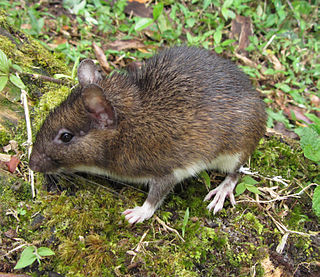
Tokudaia is a genus of murine rodent native to Japan. Known as Ryūkyū spiny rats or spinous country-rats, population groups exist on several non-contiguous islands. Despite differences in name and appearance, they are the closest living relatives of the Eurasian field mouse (Apodemus). Of the three species, both T. osimensis and T. tokunoshimensis have lost their Y chromosome and SRY gene; the sex chromosomes of T. muenninki, on the other hand, are abnormally large.

The white-spined Atlantic spiny rat is a spiny rat species endemic to Brazil.

The soft-spined Atlantic spiny-rat is a spiny rat species from South America. It is endemic to Brazil.

Elias's Atlantic spiny-rat or the Rio de Janeiro spiny rat, is a spiny rat species from South America. It is found in Brazil.

Trinomys gratiosus is a species in the mainly South American family Echimyidae, the spiny rats; it occurs in southeast Brazil from the south bank of the River Doce, Espirito Sante, southward to Teresopolis, Rio de Janeiro.
Ihering's Atlantic spiny-rat or Ihering's spiny rat is a spiny rat species from South America. It is endemic to Brazil, and was named in honor of Hermann von Ihering.

The dark-caped Atlantic spiny rat or Mirapitanga spiny rat, is a spiny rat species from South America. It is found in Brazil.

Moojen's Atlantic spiny-rat, is a spiny rat species from South America. It is found in Brazil. It is named after twentieth-century Brazilian zoologist João Moojen.

The spiked Atlantic spiny-rat or Espirito Santo spiny rat, is a spiny rat species from South America. It is found in Brazil.

The hairy Atlantic spiny rat is a spiny rat species from South America. It is endemic to Brazil.

Yonenaga's Atlantic spiny-rat or torch-tail spiny rat is a spiny rat species endemic to Brazil. Locally, it is known as rabo de facho. Named for Yatiyo Yonenaga-Yassuda, a cytogenetics researcher, it is considered an endangered species due to its highly restricted distribution and ongoing habitat loss. Genetic evidence shows that it diverged from its closest living relative, the hairy Atlantic spiny rat, around 8.5 million years ago, during the Late Miocene.

The Atlantic spiny rats are all found in the genus Trinomys. They are a group of South American spiny-rats in the family Echimyidae.

Proechimys is a genus of South American spiny rats of the family Echimyidae. All species of the genus are terrestrial. In the lowland Neotropical forests, Proechimys rodents are often the most abundant non-volant mammals. They are recognizable by reason of their elongated heads and long rostra, large and erect ears, narrow and long hind feet, and tails always shorter than head-and-body lengths. The dorsal pelage comprises a mixture of expanded, varyingly stiffened spines — hence the vernacular name of spiny rats — and soft hairs.

Tome's spiny rat, also known as Tomes' spiny rat or the Central American spiny rat, is a species of spiny rat distributed from Honduras to Ecuador. The IUCN has assessed its conservation status as being of "least concern".

Euryzygomatomys is a genus of South American rodents, commonly called guiaras, in the family Echimyidae. It contains two extant and one fossil species, found in Argentina, Brazil and Paraguay. They are as follows:
Clyomys is a South American rodent genus in the family Echimyidae. It contains two species, found in tropical savannas and grasslands from circa 100 m (300 ft) to 1,100 m (3,600 ft) elevation in central Brazil and eastern Paraguay.

Echimyidae is the family of neotropical spiny rats and their fossil relatives. This is the most species-rich family of hystricognath rodents. It is probably also the most ecologically diverse, with members ranging from fully arboreal to terrestrial to fossorial to semiaquatic habits. They presently exist mainly in South America; three members of the family also range into Central America, and the hutias are found in the Greater Antilles in the Caribbean. Species of the extinct subfamily Heteropsomyinae formerly lived on Cuba, Hispaniola, and Puerto Rico in the Antilles, probably until the arrival of Europeans.
















